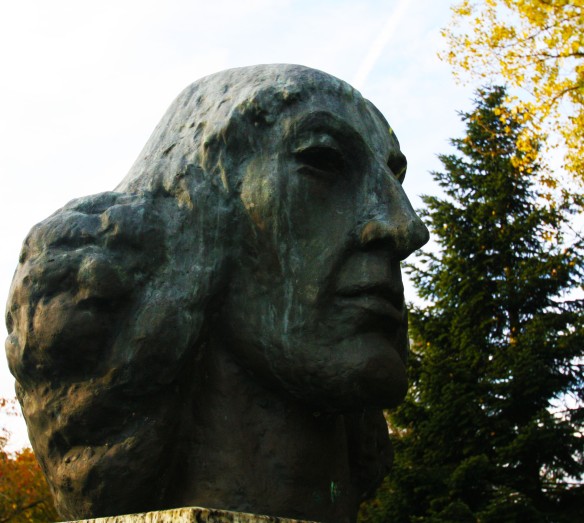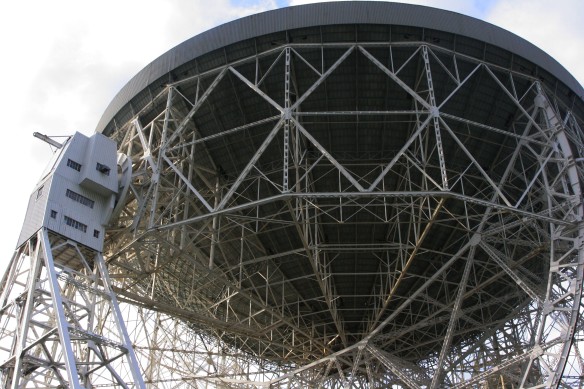This world renowned facility dates back to 1945 when the physicist and radio astronomer Bernard Lovell, following his work during WWII on the development of radar, took up a post at the University of Manchester to observe cosmic rays. The project required a ‘quiet’ site away from the noise of the city to observe the solar system. The University chose its botanical station at a little known place called Jodrell Bank, near Holmes Chapel in Cheshire 20 miles south of Manchester, to build a radio telescope. Bernard Lovell was the first Director of what became the Jodrell Bank Observatory, from 1945 to 1980 when he retired. He sadly died aged 98 in August this year.
Jodrell Bank is only 45 miles from the Wirral and with a rare day off I went along to the Discovery Centre on the site to find out more about this leading radio astronomy facility. I have seen the telescope several times from afar. Driving home as you come from to Buxton you can see Jodrell Bank on the Cheshire Plain far below the Derbyshire Peak District its white shape gleaming against a green backdrop. Today I took a close up view of the facility.
The telescope was designed so that it could be pointed to any part of the sky. It is a fully steerable and tiltable telescope with a solid steel surface dish capable of focussing radio waves from space to the monitoring station located in the gounds. It was completed in the summer of 1957 and in October that year it followed the launch by the then Soviet Union of the first satellite into earth orbit, Sputnik 1. The Mk1 telescope (now known as the Lovell Telescope being the largest of the four telescopes on the site) was able to track the progress of the launch rocket by radar. This brought the telescope into the public’s eye and it was realised that Britain had built a unique instrument which was in great demand for monitoring the satellites and space craft that were launched by the US and USSR as part of the ‘space race’ in the 1960’s. Whilst this was never a major part of the telescopes’ work, the payments for its use helped pay the debts that were outstanding for its original construction together with a large donation by Lord Nuffield and the Nuffield Foundation.
The main Lovell Telescope is 76m wide and it is still the third largest steerable radio telescope in the world. There are three other active telescopes located at the observatory; the 28x 25m diameter Mark II, as well as 13m and 7m diameter radio telescopes.
Jodrell Bank has played an important role in the research of meteors, quasars, pulsars, masers as well as the tracking of space probes. Jodrell Bank Observatory is the base of the Multi-Element Radio Linked Interferometer Network (MERLIN), an array of seven radio telescopes spread across England and the Welsh borders connected together which allows the astronomers to be able to collect more data from space. The dish is moved around on a track with large bogey wheels which slowly move the telescope to face the correct direction or ‘azimuth’ and large motors mounted on the semi circular arms are able to tilt the dish to the required angle of inclination to observe the relevant part of the sky being studied.
The Discovery Centre has an interactive experience which includes exhibits about the planets and the solar system. It includes this beautiful clockwork orrery in the centre of the exhibition room. An orrery is a mechanical device that illustrates the relative positions and motions of the planets and moons in the Solar System. Though the Greeks had working planetaria, the first orrery that was a planetarium of the modern era was produced in 1704, and one was presented to the Earl of Orrery who then gave his name to the devise. As with this model built by Smith and Nephew of Liverpool an orrery is typically driven by a clockwork mechanism with a globe representing the Sun at the centre, and with a planet at the end of each of the arms.
In the grounds around the telescope there is a statue showing Nicolaus Copernicus the Renaissance astronomer and whose controversial proposal was that rather than the earth it was the sun which was in the centre of the universe and the earth revolved around it. He is regarded as the father of modern astronomy.
The astronomers and physicists at the Observatory can access the giant dish through a series of walkways, lifts and steps. The surface of the Lovell Telescope has been renewed on two occasions the last being in 2002.
Jodrell Bank remains a world leader in radio astronomy-related research and technology development and research across the electromagnetic spectrum. Next time I see the telescope from a far on my travels I will remember my visit and experience being close up today.










